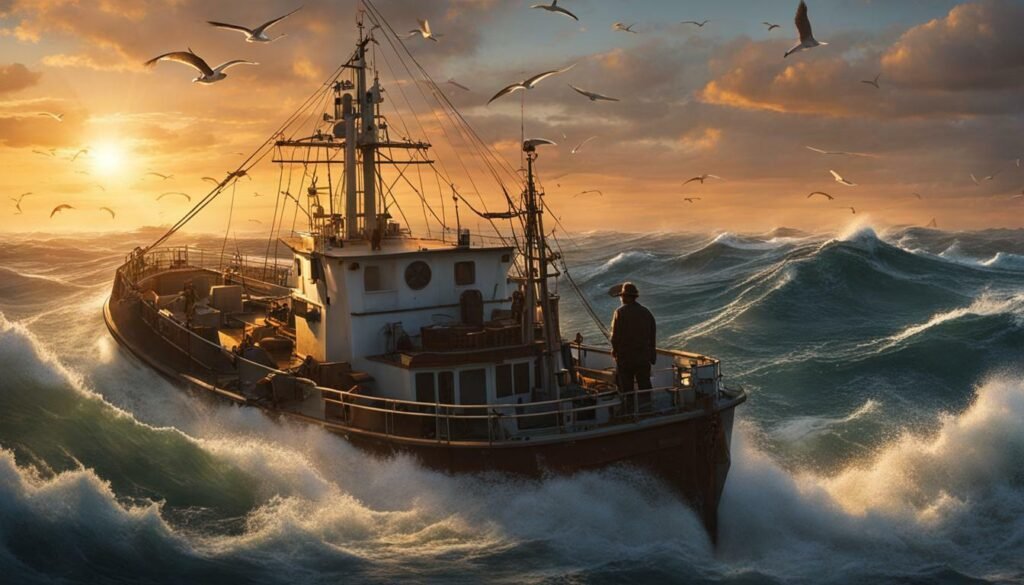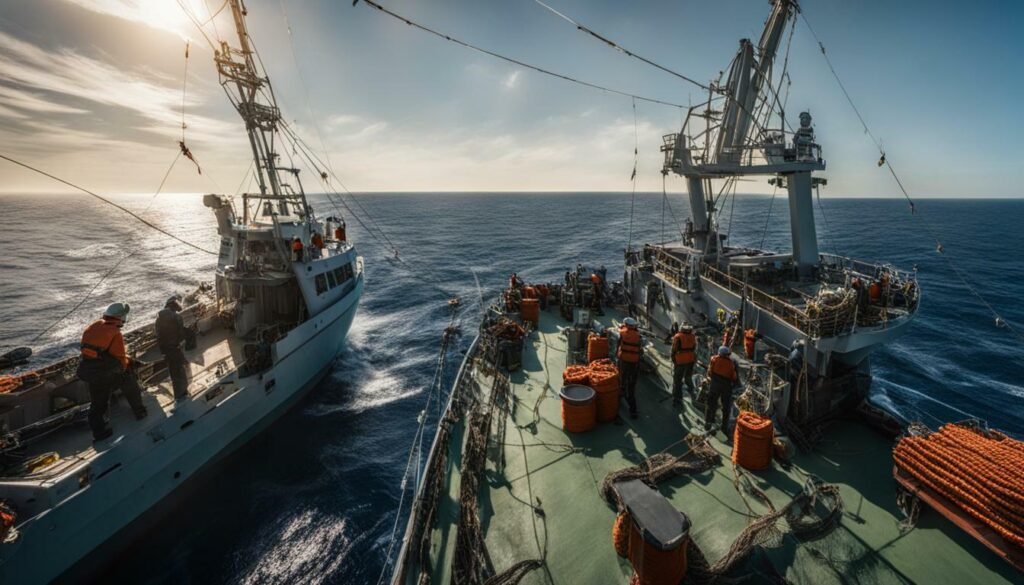Explore Canada's Ultimate Fishing, Hunting, and Wildlife Adventures

Can You Fish While Moving on a Ship? Have you ever wondered if you can enjoy a day of fishing while aboard a moving ship? In this comprehensive guide, we will unravel the truth and provide you with all the necessary information about fishing on a ship.
Yes, it is possible to fish while moving on a ship, including a cargo ship. However, it comes with its own set of challenges and considerations. The unpredictable water movements, equipment stability, and limited space can make fishing on a moving vessel a unique experience.
To enhance your fishing trip, it is crucial to choose the right equipment that can handle the motion of the ship. Selecting an ideal fishing spot is also important, as it can significantly impact your chances of landing a catch.
Adapting to the ship’s movement is key in ensuring a successful fishing experience. This may involve adjusting your fishing style, maintaining balance, and maximizing your chances of hooking a fish.
Using anchors and drift fishing techniques can help stabilize your fishing experience on a moving ship. These methods can increase the likelihood of attracting fish and improve your chances of a successful catch.
While enjoying your fishing adventure, it is essential to prioritize safety. Wearing a life jacket and being mindful of your surroundings are crucial precautions to take when fishing on a moving ship.
If you’re fishing off a moving boat, mastering techniques such as maintaining balance, casting correctly, staying alert, and reeling in fish efficiently can make all the difference. Make sure you have the right gear and take advantage of the opportunities that fishing on a moving boat presents.
Transshipment, the process of transferring catch from one vessel to another, is commonly done at sea using reefers. Reefers can process, package, and transport the catch, but it can also be accompanied by illegal and unreported fishing practices. Monitoring transshipment activities, both legal and illegal, is challenging but possible using AIS and VMS data.
Key Takeaways:
- Fishing while moving on a ship is possible, but it comes with unique challenges.
- Choosing the right equipment and an ideal fishing spot is crucial for a successful fishing experience.
- Adapting to the ship’s movement and using anchors or drift fishing techniques can enhance your chances of landing a catch.
- Safety precautions, such as wearing a life jacket and being mindful of surroundings, are essential when fishing on a moving ship.
- When fishing off a moving boat, mastering techniques and having the right gear are key.
- Transshipment can lead to illegal and unreported fishing, but monitoring activities is possible with AIS and VMS data.
Table of Contents
Fishing on a Moving Ship: Challenges and Considerations
Fishing on a moving ship presents a unique set of challenges and considerations that every angler should be aware of. The unpredictable movements of the water can make it difficult to maintain stability while fishing, requiring a strategic approach to enhance the fishing experience. Limited space on the ship also adds to the complexity, making it essential to choose the right equipment and fishing spot.
One of the main challenges of fishing on a moving ship is the constant motion of the water. The waves and currents can create an unstable fishing environment, making it crucial to have equipment that can withstand the movement. Investing in sturdy rods and reels, as well as using secure rod holders, will help to maintain stability and prevent gear from being lost overboard.
Another consideration is the limited space available for fishing on a ship. Anglers must carefully choose their fishing spot, taking into account the movement of the ship and the location of any obstacles. Finding an area with optimal conditions, such as calm waters and a good fish population, will increase the chances of a successful catch. Additionally, anglers should adapt their fishing style to accommodate the limited space, using shorter casts and strategic positioning to avoid tangling lines.
Overall, fishing on a moving ship requires careful planning and adaptation to overcome the unique challenges it presents. By choosing the right equipment, selecting an ideal fishing spot, and adapting to the ship’s movement, anglers can maximize their chances of a successful fishing trip. It is also essential to follow safety precautions, such as wearing a life jacket and being aware of the surroundings. With the right approach, fishing on a moving ship can be a rewarding experience for any angler.

| Challenges | Considerations |
|---|---|
| Unpredictable water movements | Choose sturdy equipment |
| Equipment stability | Use secure rod holders |
| Limited space | Select an ideal fishing spot |
Choosing the Right Equipment for Fishing on a Ship
When it comes to fishing on a ship, selecting the right equipment is crucial for a rewarding experience. Fishing on a moving vessel presents unique challenges, and having the appropriate gear can make all the difference in landing that prized catch. Here are some key considerations when choosing your fishing equipment for use on a ship.
- Sturdy rods and reels: Opt for fishing rods and reels that are designed for stability and durability. Look for models that can withstand the movements of a ship while providing the necessary strength to reel in larger fish.
- Compact tackle boxes: Space is often limited on a ship, so it’s important to choose a tackle box that is compact and easy to transport. Look for one with multiple compartments to keep your gear organized and accessible.
- Adjustable fishing lines: Fishing lines that have adjustable tension can help you adapt to the movements of the ship. This flexibility allows you to maintain control over your line and prevent fish from breaking free during sudden shifts in the water.
- Lure selection: Consider the different types of fish you may encounter while fishing on a ship and choose your lures accordingly. Opt for versatile lures that can attract a variety of species, allowing you to maximize your chances of success.
Remember, investing in high-quality equipment will not only improve your fishing experience but also increase your chances of landing a catch while on a moving ship.
It’s also worth noting that the use of anchors and drift fishing techniques can significantly enhance your fishing experience on a ship. Anchors provide stability and help keep your position steady, while drift fishing allows you to cover a larger area and explore different fishing spots. These methods can be especially useful when the ship is in motion, ensuring that you stay in control of your fishing efforts.
Table: Essential Fishing Equipment for Fishing on a Ship
| Equipment | Description |
|---|---|
| Fishing rods and reels | Sturdy and durable models designed for stability and strength |
| Tackle box | Compact and easy to transport with multiple compartments |
| Fishing lines | Adjustable tension to adapt to the movements of the ship |
| Lures | Versatile options that attract a variety of fish species |
By carefully selecting the right equipment, you can overcome the challenges of fishing on a moving ship and enjoy a successful fishing adventure. Remember to prioritize safety by wearing a life jacket and being mindful of your surroundings. With the proper gear, preparation, and techniques, you can make the most of your fishing experience while sailing the open waters.

Finding the ideal fishing spot on a moving ship can greatly increase your chances of success. However, it can be a daunting task due to the constantly changing water movements. To overcome this challenge, consider these factors when selecting your fishing spot:
- Water Depth: Look for areas with varying water depths as fish tend to swim at different depths depending on the time of day and weather conditions.
- Water Temperature: Fish are more likely to gather in areas with stable water temperatures. Use a fish finder to identify temperature changes and locate potential hotspots.
- Underwater Structures: Check for underwater structures such as reefs, rocks, or submerged vegetation. These structures provide shelter and food sources for fish, making them attractive fishing spots.
- Currents: Pay attention to the direction and strength of currents. Fish often gather in areas where currents create eddies and bring food to them.
- Bird and Marine Life Activity: Keep an eye out for birds diving into the water or marine animals like dolphins and seals. They are indicators of baitfish and potential fishing grounds.
Remember to adapt your fishing techniques according to the ship’s movement. Use lures or bait that mimic the natural prey in the area and adjust your casting and retrieval speed accordingly. Stay alert and be patient, as it may take some time to locate the perfect fishing spot on a moving ship.
“Fishing is much more than fish. It is the great occasion when we may return to the fine simplicity of our forefathers.” – Herbert Hoover

| Water Depth | Water Temperature | Underwater Structures | Currents | Bird and Marine Life Activity |
|---|---|---|---|---|
| Varying depths attract fish at different times. | Stable water temperatures are preferred by fish. | Underwater structures provide shelter and food sources for fish. | Fish gather in areas with favorable currents. | Birds and marine life indicate potential fishing grounds. |
Adapting to the Ship’s Movement: Tips for Fishing on a Moving Vessel
Fishing on a moving ship requires a different approach to ensure a successful and enjoyable experience. The constant motion of the vessel can make it challenging to maintain stability and land a catch. However, with the right techniques and preparations, you can adapt to the ship’s movement and increase your chances of hooking a fish.
One important tip is to adjust your fishing style to accommodate the motion of the ship. If you are used to casting from a stationary position, you may need to modify your technique while on a moving vessel. Consider using shorter casts and focusing on areas closer to the ship to improve your accuracy and control.
Another key aspect is maintaining balance. The movement of the ship can cause instability, so it’s crucial to keep your center of gravity low. Plant your feet firmly on the deck and distribute your weight evenly to minimize the risk of losing your balance. Taking short, stable steps can also help you stay steady.
Lastly, staying alert is essential while fishing on a moving vessel. Pay close attention to your surroundings, including other anglers and crew members. Be mindful of any sudden changes in the ship’s movement and adjust your position or fishing technique accordingly. By staying vigilant, you can ensure your safety and the safety of others onboard.
| Adapting to the Ship’s Movement: | Tips for Fishing on a Moving Vessel |
|---|---|
| Adjust your fishing style | Shorter casts and focus on areas closer to the ship |
| Maintain balance | Keep center of gravity low, plant feet firmly, distribute weight evenly |
| Stay alert | Pay attention to surroundings, be mindful of changes in ship’s movement |
Fishing on a moving ship can provide a unique and exciting experience for anglers. By adapting to the ship’s movement, making adjustments in your fishing style, maintaining balance, and staying alert, you can increase your chances of success. Remember to always prioritize safety and follow any additional guidelines or instructions provided by the crew. Happy fishing!

Anchors and drift fishing techniques can be valuable tools when fishing on a ship, providing stability and improving the chances of a successful catch. Whether you’re on a cargo ship or any other vessel, these methods can help you overcome the challenges of fishing on a moving platform.
When using anchors, it’s crucial to select the right size and type for the conditions you’ll encounter. The anchor should be able to hold the ship securely in place, ensuring that you have a stable fishing spot. Additionally, make sure to deploy the anchor in an area with suitable bottom conditions, such as sandy or muddy areas, where it can dig in and provide a strong hold. Using multiple anchors can also enhance stability, particularly in rough waters.
Drift fishing, on the other hand, involves allowing the ship to drift naturally with the current while you cast your line and let it drift alongside the vessel. This technique works well when there’s a consistent current and can help you cover a larger area as you search for fish. To effectively drift fish, make sure to adjust your bait presentation to match the speed of the drift, and stay alert for any strikes. Consider using a drift sock or sea anchor to control the drift speed and direction, allowing for better control of your fishing area.
| Advantages of Anchors | Advantages of Drift Fishing |
|---|---|
| Provides stability | Covers a larger area |
| Allows for precise positioning | Matches the natural drift of the ship |
| Increases chances of catching stationary fish | Targets fish in various parts of the water column |
| Can be more suitable in calm or slow-moving waters | Ideal for areas with a consistent current |
By using anchors and drift fishing techniques, you can adapt to the ship’s movement and optimize your fishing experience. However, it’s essential to prioritize safety at all times. Always follow the instructions for deploying and retrieving anchors, and be cautious when using drift socks or sea anchors, especially in rough weather conditions. Remember to wear a life jacket and be aware of your surroundings to ensure a safe and enjoyable fishing trip.
“Using anchors and drift fishing techniques can significantly improve your chances of landing a catch while fishing on a moving ship. These methods provide stability, allowing you to effectively fish in changing water conditions. So, next time you embark on a fishing adventure at sea, don’t forget to bring along the right equipment and give anchors and drift fishing a try!”
Now that you know the benefits of using anchors and drift fishing techniques, it’s time to put your knowledge into practice. Experiment with different techniques and adapt to the ship’s movement to increase your chances of reeling in a memorable catch. Remember, fishing on a ship can be an exciting and rewarding experience, but it requires careful consideration and adherence to safety precautions. So, get out there and enjoy the thrill of fishing on the open seas!
Safety Precautions for Fishing on a Moving Ship
Prioritizing safety is essential when fishing on a moving ship, and taking the necessary precautions can make all the difference. Whether you’re a seasoned angler or just starting out, it’s important to be aware of the unique challenges that come with fishing on a vessel that is constantly in motion. To ensure a safe and enjoyable experience, here are some important safety measures to keep in mind:
1. Wear a life jacket:
When fishing on a moving ship, wearing a life jacket is non-negotiable. It provides an additional layer of protection and ensures that you stay afloat in case of any unexpected falls or accidents. Choose a life jacket that is comfortable, properly fitted, and approved by the appropriate maritime safety authorities.
2. Be mindful of your surroundings:
It’s easy to get caught up in the excitement of fishing, but it’s crucial to stay aware of your surroundings at all times. Keep an eye on other anglers, crew members, and any equipment or obstacles that may pose a safety risk. Stay clear of any restricted areas and follow the instructions provided by the ship’s crew.
3. Secure your fishing gear:
On a moving ship, waves and sudden movements can cause your fishing gear to become unstable. Make sure that all rods, reels, and other equipment are properly secured to prevent any accidents or damage. Use rod holders, straps, or other reliable fastening methods to keep your gear in place.
By following these safety precautions, you can enjoy fishing on a moving ship while minimizing the risk of accidents or injuries. Remember, safety should always be a top priority, allowing you to have a memorable and rewarding fishing experience.

Fishing off a moving boat requires a different skill set, and these techniques and tips will help you master the art. As the boat sways and bobs, it’s important to maintain your balance to avoid any accidents. Stand with your feet shoulder-width apart and bend at your knees slightly to stabilize your stance. This will ensure that you are steady on your feet and ready to reel in the big catch.
Casting correctly is crucial when fishing off a moving boat. Aim your cast slightly ahead of your target to compensate for the boat’s movement. This way, when your bait or lure reaches the desired spot, the boat will have caught up, increasing your chances of success. Be patient and wait for the boat to settle before reeling in, as this will give your bait enough time to attract the fish.
Staying alert is key when fishing off a moving boat. Keep an eye out for any changes in the water’s surface, such as ripples or swirls, as they could indicate the presence of fish. Stay mindful of your surroundings, including other anglers on the boat, to avoid tangles or collisions. Remember, safety should always be your top priority.
Top Tips for Fishing off a Moving Boat
- Use lighter tackle and smaller lures to compensate for the boat’s movement and increase your chances of attracting fish.
- Pay attention to the direction of the wind and cast with it to cover more water effectively.
- Opt for live bait, as its natural movement will be more enticing to fish in a moving environment.
- Consider using a rod holder or securing your rod to the boat to free up your hands and avoid any accidents.
With these techniques and tips, you’ll be well-equipped to enjoy a successful fishing experience off a moving boat. Remember to practice patience and adapt your fishing style to the unique conditions of being on the water. So grab your gear, find your balance, and cast away!
| Technique | Description |
|---|---|
| Bend at the Knees | Ensure balance by bending your knees slightly and widening your stance. |
| Cast Ahead | Aim your cast slightly ahead of your target to account for the boat’s movement. |
| Stay Alert | Pay attention to changes in the water and be mindful of your surroundings. |
Transshipment: The Process of Catch Transfer on Ships
Transshipment plays a crucial role in the fishing industry, but it also comes with its own challenges and concerns. It involves the transfer of catch from one vessel to another, often done at sea using specialized vessels called reefers. These reefers are equipped to process, package, and transport the catch, ensuring its freshness and quality throughout the journey.
During transshipment, fish are typically transferred from fishing vessels to larger carrier ships or processing plants. This allows for efficient collection and distribution of catch, especially in remote or offshore fishing areas. The catch is stored in refrigerated holds on the reefer vessels to maintain optimal temperature and prevent spoilage. This process helps seafood suppliers meet the demands of consumers worldwide and keep the industry running smoothly.
| Benefits of Transshipment | Concerns with Transshipment |
|---|---|
|
|
While transshipment provides various benefits, it also comes with concerns. One of the major concerns is the potential for mixing legal and illegal fish during the catch transfer process. This can lead to illegal and unreported fishing practices, compromising the sustainability and legality of the seafood industry. Monitoring and enforcing regulations surrounding transshipment activities can be challenging but are crucial for combating these issues.
To ensure the sustainability of the fishing industry, it is essential to implement effective monitoring measures for transshipment activities. One such method is the use of Automatic Identification System (AIS) and Vessel Monitoring System (VMS) data. These systems track vessel movements and provide valuable information for monitoring and enforcing regulations. By analyzing this data, authorities can identify suspicious activities and take appropriate action to prevent illegal fishing practices.

In conclusion, transshipment is a vital process in the fishing industry, enabling efficient catch transfer and distribution. However, it also poses challenges such as the mixing of legal and illegal fish and the risk of illegal fishing practices. Monitoring transshipment activities using AIS and VMS data is crucial for maintaining sustainable fishing practices and ensuring the integrity of the seafood industry.
Monitoring Transshipment Activities for Sustainable Fishing
Monitoring transshipment activities is vital in ensuring sustainable fishing practices, and technology plays a key role in effective monitoring. Transshipment, the transfer of catch from one vessel to another, can be done at sea using refrigerated cargo ships, known as reefers. These reefers not only process, package, and transport the catch but also provide an opportunity for illegal and unreported fishing activities.
AIS (Automatic Identification System) and VMS (Vessel Monitoring System) data are valuable tools for monitoring transshipment activities. AIS data, received from vessel broadcasts, allows authorities to track vessels in real-time and identify suspicious fishing practices, such as transshipment in areas where it is prohibited. VMS data, collected from fishing vessels, provides additional information on vessel movements, catch quantities, and fishing methods, enabling more comprehensive monitoring.
By analyzing AIS and VMS data, authorities can identify and investigate potential cases of illegal transshipment, ensuring that fish stocks are not overexploited, and fishing regulations are adhered to. It also allows for the detection of vessels involved in illegal, unreported, and unregulated (IUU) fishing, which is crucial for maintaining the sustainability of marine ecosystems.

Illegal transshipment activities pose a significant threat to sustainable fishing practices. They allow for the mixing of legal and illegal catch, making it difficult to trace the origin of fish and ensure their legality. Monitoring transshipment activities helps prevent this practice, safeguarding the integrity of the seafood supply chain and protecting vulnerable marine species.
| Methods of Monitoring Transshipment Activities | Advantages |
|---|---|
| AIS data analysis | Real-time tracking of vessel movements, identification of suspicious activities |
| VMS data analysis | Insights into fishing methods, catch quantities, and vessel trajectories |
| Collaboration with international organizations | Sharing information and coordinating efforts to tackle transshipment-related issues |
In conclusion, monitoring transshipment activities plays a crucial role in promoting sustainable fishing practices. By leveraging technology and data analysis, authorities can identify and prevent illegal fishing activities, protect marine ecosystems, and ensure the long-term viability of our fisheries.
Conclusion
Fishing while moving on a ship is indeed possible, but it requires proper preparation, skill, and a keen awareness of the unique challenges posed by a moving vessel. As discussed in this article, there are several considerations to keep in mind to enhance your fishing experience on a ship.
First and foremost, choosing the right equipment is crucial. Opt for sturdy and stable gear that can withstand the movement of the ship. Make any necessary modifications to ensure your equipment is suitable for fishing on a moving vessel.
Next, selecting an ideal fishing spot is key. Look for areas with optimal conditions, taking into account factors such as water depth, currents, and potential fish activity. By finding the right location, you increase your chances of a successful catch.
Adapting to the ship’s movement is also essential. This involves adjusting your fishing style and maintaining balance while on board. By staying aware of the vessel’s motion and making necessary adjustments, you can improve your chances of hooking a fish.
Furthermore, the use of anchors or drift fishing techniques can help stabilize your fishing experience. Anchors can provide stability in a specific fishing spot, while drift fishing allows you to cover a larger area without the need for an anchor.
Lastly, it is crucial to prioritize safety. Always wear a life jacket while fishing on a moving ship and be mindful of your surroundings. Following safety guidelines ensures a safe and enjoyable fishing trip for everyone on board.
In conclusion, with the right preparation and considerations, fishing while moving on a ship can be an exciting and rewarding experience. By being equipped with suitable gear, selecting the right fishing spot, adapting to the ship’s movement, and prioritizing safety, you can make the most of your fishing adventure at sea.
FAQ about Can You Fish While Moving on a Ship
Can I fish while the ship is moving?
Yes, it is possible to fish while moving on a ship, including a cargo ship. However, there are unique challenges and considerations that come with fishing on a moving vessel.
What challenges should I expect when fishing on a moving ship?
Fishing on a moving ship presents challenges such as unpredictable water movements, equipment stability, and limited space. It is important to be aware of these challenges and make the necessary adjustments for a successful fishing experience.
How do I choose the right equipment for fishing on a ship?
Choosing the right equipment for fishing on a ship is essential. It involves selecting gear that can withstand the ship’s movement and making any necessary modifications to ensure stability and functionality.
How do I select an ideal fishing spot on a moving ship?
Selecting an ideal fishing spot on a moving ship requires careful consideration. Factors such as water conditions, currents, and wind direction should be taken into account to maximize your chances of a successful catch.
How can I adapt to the ship’s movement while fishing?
Adapting to the ship’s movement while fishing involves adjusting your fishing style and techniques to accommodate for the vessel’s motion. This includes maintaining balance, adjusting casting technique, and staying alert to changes in water movements.
Are there specific techniques for fishing off a moving boat?
Yes, fishing off a moving boat requires specific techniques to maximize your chances of success. This includes maintaining balance, casting correctly, staying alert, and reeling in fish efficiently to compensate for the vessel’s movement.
How can I ensure safety while fishing on a moving ship?
Ensuring safety while fishing on a moving ship is crucial. It is advisable to wear a life jacket, be mindful of your surroundings, and follow safety guidelines to prevent accidents and ensure an enjoyable fishing trip.
What is transshipment and how does it relate to fishing?
Transshipment refers to the transfer of catch from one vessel to another. It is often done at sea using reefers, which can process, package, and transport the catch. However, transshipment can also lead to issues such as illegal and unreported fishing by mixing legal and illegal fish.
How can transshipment activities be monitored for sustainable fishing?
Monitoring transshipment activities, both legal and illegal, can be challenging but can be done using AIS and VMS data. Effectively monitoring transshipment is crucial for promoting sustainable fishing practices and preventing illegal activities.
Is fishing while moving on a ship possible?
Yes, it is possible to fish while moving on a ship. However, it requires careful consideration, suitable equipment, and adherence to safety precautions for an enjoyable and successful fishing experience.
Source Links
- https://pdfebooks4u.com/can-you-fish-while-moving-on-a-ship
- https://www.boatingworld.com/question-answer/how-does-one-fish-off-a-moving-boat/
- https://globalfishingwatch.org/fisheries/rendezvous-at-sea-what-is-transshipping/








